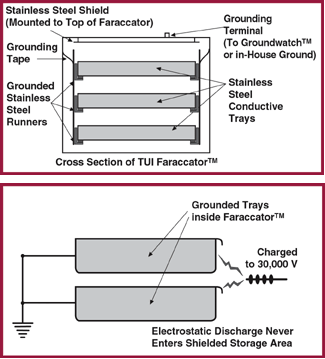- What is electrostatic discharge?
- How is it generated?
- How does it damage microelectronic devices?
- How can it be controlled?
- What are the advantages and disadvantages of static control methods available today?
Why all the Static?
Static electricity is an excess or deficiency of electrons on a surface. The total number of deficient or excess electrons determines the charge on that surface. A surface exhibiting an excess of electrons is charged negatively, and an electron-deficient surface is charged positively.
How are Electrostatic Charges Generated?
Electrostatic charges are usually generated by friction between and/or separation of two dissimilar materials, at least one of which is a nonconductor or a poor conductor of electricity. The accumulated charge (static) resides on the surface of, rather than within, the charged nonconductive object.
Electrostatic discharge (ESD) occurs when an accumulated charge (which may be present on an operator, the operator's clothing, or on any other non-conductive object) is discharged through a conductor (which may be part of a wafer, a chip, or a packaged device), and it may occur whenever the electrostatic potential corresponding to accumulated charge is great enough.
How Do Electrostatic Charges Damage Sensitive Devices?

Microelectronic devices are degraded or destroyed by static in two ways: by excessive voltage and by excessive current. An operator can easily damage the devices he is working with in either of these ways. A voltage-sensitive device may be damaged by exposure to the extremely high field intensity surrounding a highly-charged person (charges may reach as high as 5000V). On the other hand, if he touches the device, an operator may pass a transient discharge directly through it. This electrostatic discharge (ESD) produces such a high current density that it can overheat and even melt current-sensitive circuitry.
Manufacturers have taken steps to combat these problems throughout the manufacturing process, but until recently, little was done to ensure static-free storage. Desiccator cabinets provide protection against contaminants, but nearly all are made of acrylic, one of the most prolific generators of ESD.
Why Use Acrylic in Desiccator Manufacturing?
In critical contamination-control and static-control applications, you shouldn't.
Acrylic features many attractive characteristics: it allows easy and inexpensive fabrication, permits optimal viewing of stored parts, and stands up to the most rugged manufacturing and stockroom conditions. Yet it also generates static charges. Not only does this static generation threaten sensitive components, but it also makes your desiccator a dust magnet. Particles that cling to charged acrylic surfaces threaten parts, diminish visibility, and are difficult to remove.
Hence, acrylic desiccators can be a dangerous place to store microelectronic parts. For this reason, transparent static-dissipative plastics (such as Terra's static-dissipative PVC) are becoming the industry standard in cleanroom applications.
How Can Electrostatic Discharge be Controlled?
The basic concept behind static protection for microelectronic components is the prevention of static buildup whenever possible and the quick, reliable removal of already existing charges. The means by which these charges are removed depends on whether the charged object is a conductor or a nonconductor (insulator). Both types of materials coexist throughout the semiconductor manufacturing environment.
Once a nonconductive surface has obtained a charge, the only way it can be neutralized is by means of an ion source. Both positive and negative surface charges are eliminated on nonconductive surfaces by ions of the opposite polarity which neutralize surface charges. Static decay times are directly related to the number of airborne ions; the more negative ions, the faster the decay time for positive charges (and vice versa).
For conductive materials, Terra's Faraccator™ concept guarantees 100% ESD protection within a storage area.
Terra has developed a complete line of noncontaminating stainless steel shelves, trays, and drawers that guarantee the absolute conductivity required for a Faraday cage. These durable units come in standard sizes to fit all of our desiccator cabinets and provide organized storage—both inside and outside the desiccator.
Do these Units Provide the Same Static-Proof Protection when Removed?
Absolutely. Shelves and trays interlock to form sturdy, static-free carrying containers. Even though the unit is not grounded outside the desiccator, its own capacitance lets it absorb a great deal of static charge without affecting stored material. Our grounded, chrome-plated racks even let you stack these storage—both maintaining a static-free environment.
Terra also offers a full line of Faraccator™ storage cabinets that incorporate slide-out conductive drawers and stainless steel inlays. Like the trays and shelves, these drawers continue to shield against ESD when removed and used as carrying containers.
Can Terra Desiccators be Retrofitted to Deliver the ESD-Free Protection of a Faraccator™?
Easily. For each of our desiccators we offer chrome-plated racks that accept standard trays and shelves and, connected to a suitable ground, deliver complete electrostatic protection.
Our GroundWatch™ device helps to enhance this protection by continuously monitoring the integrity of the ground connection of an indefinite number of desiccators. The minute a ground line is disrupted, visible and audible alarms alert you to the problem before stored parts can be damaged.
Which Method of ESD Control is Best Today?
The answer depends on the type of material you need to protect. If stored material is conductive or dissipative (material placed in conductive bags or boxes, conductive waffle packs, etc.):
- Take advantage of Terra systems based on the Faraday concept.
- Material up to 4" (102 mm) high
- Faraccators
- Security Faraccators
- Larger Materials
- Stainless Steel Desiccators
- Double Agent Desiccators
- Desiccators with Stainless Steel Shelving
- Select Dissipative PVC Desiccators in conjunction with stainless steel shields, shelves, and trays.
If stored material is nonconductive (plastic boxes, nonconductive waffle packs, etc.), or if stored material is already charged and must be neutralized, we recommend ionizing equipment in addition to the safety measures listed above. For additional protection, use conductive trays in conjunction with ionizing nozzles whenever possible.
Solutions to Static Problems: The Faraccator™ Concept
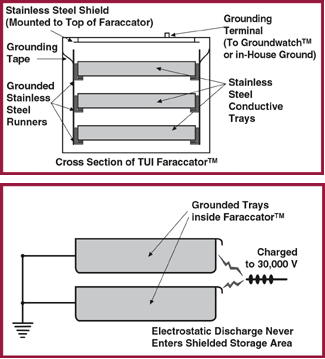
The British physicist Michael Faraday long ago observed that a charged body will induce the opposite charge on a metal object placed next to it, thereby establishing an electric field. If the difference in electrical potential between the two objects is high enough to ionize the air between them, a static discharge will occur accompanied by a flow of current through the ionized air that neutralizes this potential. Needless to say, this discharge could damage a sensitive circuit of limited current-carrying capacity.
Faraday reasoned that an electric conductor cannot maintain an electric field because any difference in potential would be immediately neutralized by the conductor's free electrons. Hence, any volume enclosed within a conductor (such as a metal box) will be completely shielded from static charges.
Terra's Faraccators work on just this principle. They consist of a metal shield above a metal tray that stores sensitive parts.
Although this configuration does not form the closed box that Faraday described, both shield and tray are at the same potential and no electric field can exist within the volume they enclose. This effect can be demonstrated simply by directing an electrical discharge at the opening between the shield and the tray. The discharge never enters the cavity, and any stored materials inside remain completely shielded from the effects of the discharge
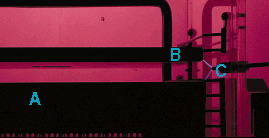
Actual Test on Terra Faraccator
- Grounded Tray
- Grounded Shield
- 30,000 volts
Solutions to Static Problems: Automatic IonWatch™ Ionizing Equipment
This revolutionary ionizing equipment offers one feasible solution to the problem of effective static and contamination control. By installing a single ionizing nozzle in each desiccator compartment, you can effectively neutralize surface charges within that compartment. Ionizing bars deliver this same protection in Laminar Flow Stations, Wet Processing Stations, and under the Terra Universal Hood. This equipment performs several important functions:
- It eliminates the buildup of static charges that can damage sensitive materials. Free ions combine with charge imbalances that develop on nonconductive surfaces (such as acrylic), thereby eliminating the possibility of electrostatic discharges. This continuous neutralization is especially important in acrylic desiccators.
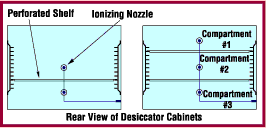
- It also neutralizes charges already existing on nonconductive materials placed into the desiccator or work station. This second function is especially important since charges on nonconductive surfaces cannot be removed simply through grounding. In most cases, ionizing equipment is the only feasible way to remove these charges.
- By neutralizing surface charges, ionizing equipment helps to control contamination. Everyone knows how "static cling" makes it difficult to remove lint from clothing; the same force can make it nearly impossible for a laminar flow of air to remove minute particles. Without the proper ionizing equipment, your laminar flow station may be nearly worthless.
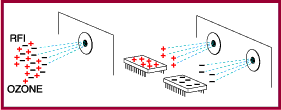
Terra Universal's Automatic lonWatch™ Ionizing Power Supply makes ionization an especially safe and practical solution. This unit does not generate sufficient energy to create radio frequency interference (RFI) or ozone—common problems with AC equipment.
And unlike other DC power supplies, this unit generates both positive and negative ions from a single nozzle—sensing the size of an existing charge imbalance and emitting the appropriate polarity of ions required to neutralize it. This means that you only need one nozzle per chamber, and that objects can be placed next to a nozzle without being exposed to a charge imbalance. And because this unit is completely self-balancing, it requires no routine maintenance.
Note: When ordering ionizing equipment, remember that you need a separate nozzle for each compartment. Free ions will not penetrate through perforations in plastic or stainless steel shelves, so each time you add a shelf you in effect create a new chamber and must add a new nozzle.
Solutions to Static Problems: Static-Dissipative Plastics: The Best of Both Worlds
Terra is proud to offer a wide range of static-dissipative materials that combine the high visibility and light weight of acrylic with the static-dissipative protection you need.
Our Static-Dissipative PVC is available on any desiccator we sell. This economical material features permanent static-dissipative coatings on both sides; in tests conducted in accordance with Mil-B-81705B, this material met the 2.0 second static decay requirement to zero as specified; in fact, it had a decay time of 0.01 seconds for each measurement taken. It features a surface resistivity between l06 and l08 ohms/square, and resists a wide range of corrosive chemicals without suffering any reduction of static-dissipative properties (see separate catalog listing for full specifications).
Because this material will not accumulate surface charges, it won't attract charged particles. It is thus ideal for use in Terra's Vertical Laminar Flow Stations, Universal Hoods, Wet Processing Stations, Auto Strat Desiccators, and any other application that requires the transparency of acrylic without its static cling. It does not outgas, so it is completely safe for use in your cleanroom. It comes in a variety of thicknesses.
Terra also offers a number of other static-dissipative materials to suit special applications (Call Terra for full specifications):
- Flexible Static-Dissipative PVC: This material features all of the characteristics of the rigid material described above, but its flexibility makes it ideal for cleanroom curtains, dust covers, microenvironments, and other applications requiring a softer material.
- Static-Dissipative Clear Polycarbonate: This rigid material will withstand high temperatures without melting or generating smoke. It is perfect for use in exhaust hoods where visibility and high thermal resistance are required.
- Static-Dissipative Acrylic: This high-performance plastic plate has superb methacrylate properties with static-dissipative surfaces.
Dissipative vs. Conductive: Which is Best?

Conductive materials effectively remove static surface charges—in many cases, too effectively!
Consider the case of two identically charged objects, one placed in a conductive and the other in a dissipative enclosure. The higher current flow through the conductive material will facilitate more rapid and potentially disruptive discharge to ground. In fact, the probability of an electrostatic discharge—the very event that a static-safe enclosure is designed to prevent—is higher with a conductive material. The greater resistance offered by a dissipative material facilitates a slower, safer discharge to ground, at a much lower current level.



